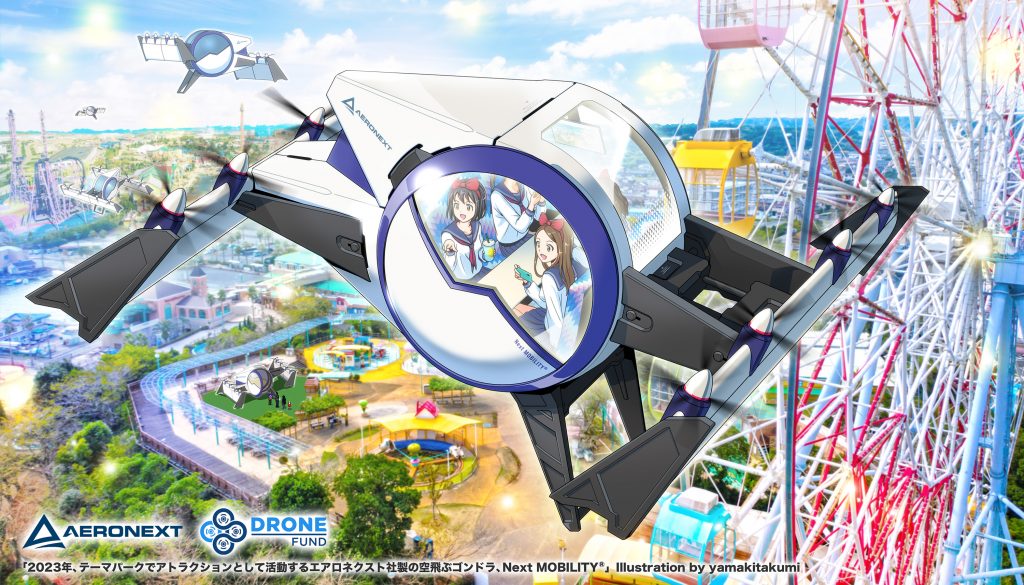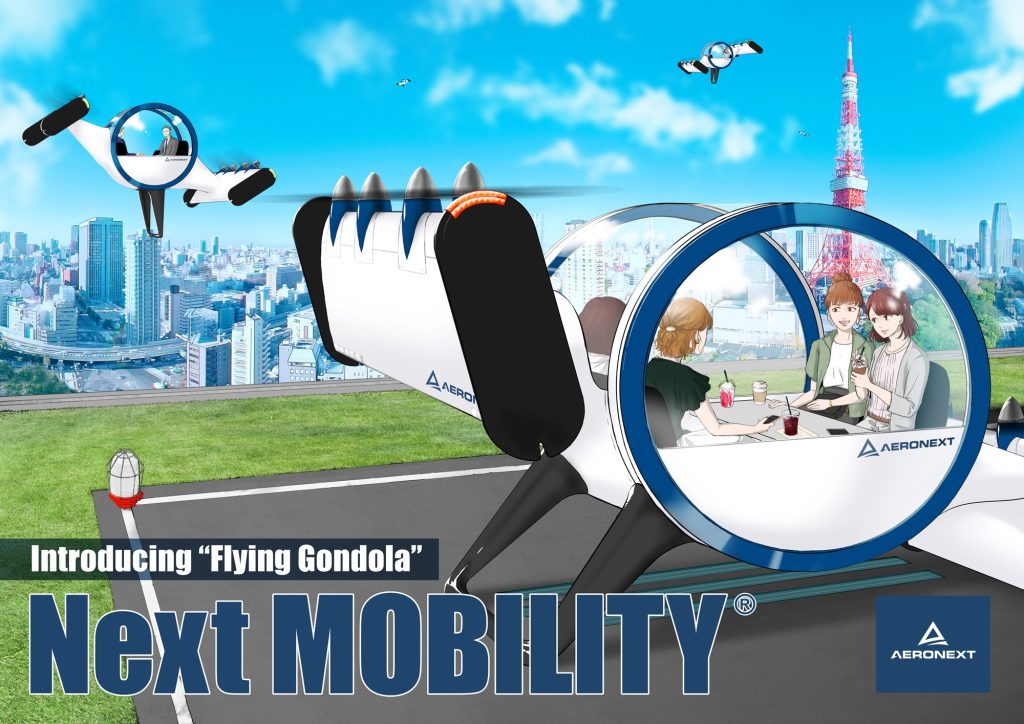

ブログ
Increasing the acceptance of Drone transportation with the Concept of the Flying Gondola by 2023

The Flying Gondola is a new concept in air mobility announced by Aeronext in October 2019. Equipped with 4D GRAVITY®︎ and other proprietary technologies, it achieves both safety and comfort in air mobility, and is a realistic solution that will enhance the social acceptance of air mobility by providing people with a new flying experience.

A New Concept in Air Mobility: The Flying Gondola
The Flying Gondola is a new concept in air mobility announced by Aeronext in October 2019. It is a concept that sets it apart from other air mobility concepts, such as “flying cars” and is focused on providing mobility convenience.
A Flying Gondola imagines a vehicle like a gondola of a Ferris wheel that can fly in the sky. A Ferris Wheel is a vehicle that allows all, young and old, to get on and off without difficulty, has a stable ride without shaking, and allows everyone to enjoy extraordinary views from high places.
The Flying Gondola concept derives its safety and comfort of air mobility from the use of Aeronext’s proprietary technology, such as 4D GRAVITY® to provide people with a new flying experience.
3 Features of The Flying Gondola
The Flying Gondola concept means that anyone can ride, even if they do not have the skills to operate air mobility vehicles or have special qualifications. It allows people to relax in a safe and comfortable space and enjoy the experience of flying in the sky. We emphasize three Features of the flying Gondola.
The Flying Gondola Is Remotely Controlled and Automatically Navigated
The first feature of Flying Gondola is that it is remotely controlled and uses automatic navigation using an air mobility control tower, remote-controlled and automatic navigation of the vehicle that monitors and controls all takeoff, landing, and flight. It is completely different from airplanes, helicopters, and “Flying Cars” in that no pilot is required, and anyone can easily ride without having any piloting skills.
The Flying Gondola: An eVTOL-type of Air Mobility
The second feature of the Flying Gondola is the “eVTOL” capability. Pinpoint takeoff and landing is possible with an electric eVTOL (Electric Vertical Take-off and Landing Aircraft) that is equipped with both fixed wings and rotating wings. Leaving the option of gliding in the event of an emergency is essential for air mobility safety.
Equipped with Aeronext’s proprietary technology, it enables smooth takeoff and landing and level flight, leading to improved fuel efficiency, reduced wear of parts and reduced risk of failure.
The Flying Gondola Is Safe and Comfortable
The third feature of Flying Gondola is that it is safe and comfortable. Equipped with Aeronext’s proprietary technology, including 4D GRAVITY®︎, sway of the cabin is minimized. The cabin can be kept horizontal during take-off and landing and level flight, so you can ride comfortably and passengers can relax while traveling.
If you’re a single passenger, you’ll be able to listen to music, watch your smartphone, and hold meetings. If there are two or more people riding, you can enjoy unique space to have a conversation, a snack, or even take pictures for instagram of the superb view in the background.

By 2023, Flying Gondolas will allow people to enjoy scenery at amusement parks and sightsee.
Flying Gondolas are likely to be used as leisure activities for unique experiences at amusement and tourist areas. Considering various aspects such as flight safety management, maintenance of regulations, motivation to use, business profitability, etc., the area and usage of air mobility should be limited at first in order to gain experience in actual operations.
The Flying Gondola Begins a New Airspace Economics
We wish to emphasize the emergence of “new airspace.” The Burj Khalifa, 828 meters above the ground in Dubai, and other skyscrapers allow us to enjoy the view from the airspace directly above the ground, and these are increasing all over the world. This, however, is only an extension of the ground.
The extraordinary experience of flying like a bird at mid-range altitude that is higher than the rooftop of a typical building and lower than looking down from an aircraft will become a new entertainment for the general public with the advent of a Flying Gondola.
New businesses will emerge to acquire users in new airspaces, and activities to navigate the opportunities in these new airspaces. Also the spaces themselves, through advertising and sampling, will also become active business arenas. The realization of the flying gondola will change the current urban design.
Flying Gondola is a real solution to increase social acceptance of air mobility
More than 90% of air mobility projects currently being developed around the world are intended to be a new means of transportation for issues such as mitigating traffic congestion caused by explosive population growth in urban areas.
However, it is expected that social implementation will take some time for Flying Cars, such as the necessity of establishing a new regulations and systems to operate air mobility will be needed and separate from car driving licenses and regulations.
On the other hand, the issue with the cabin tilting as the aircraft tilts is problematic as the safety and comfort are impacted. These issues are of the same importance or even more important than the efficiency of traffic movement.
Envisions a Flying Gondola is a strop to ensure more and more people can enjoy a new flight experience safely and comfortably and is a shortcut to increase the social acceptability of air mobility and speed implementation. Of course, air mobility will ultimately be a means of transportation, and will be responsible for the air travel of MaaS.
The First prototype “Next MOBILITY®︎” Embodies the Flying Gondola
Next MOBILITY®︎ is the first principle prototype that embodies this new concept of air mobility and The Flying Gondola concept announced by Aeronext. This is a one-third-size prototype of a single-seat aircraft, and successfully completed its first flight in October 2019. In the future, we will also develop single-seat, full-size, two-seat and four-seat aircraft.